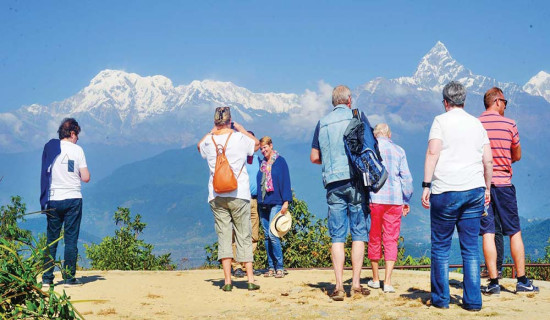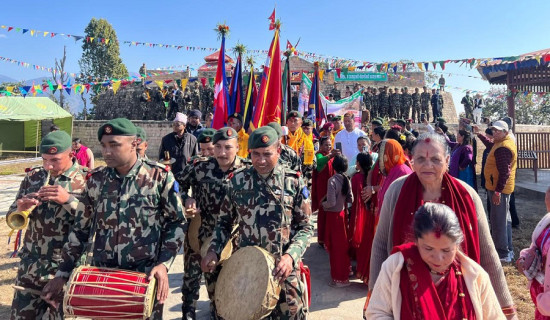- Thursday, 8 January 2026
Boost Kathmandu-beautifying Campaign
When he became Mayor of the Kathmandu Metropolitan City (KMC) in 2022, Balendra Shah vowed to make Kathmandu one of the world’s most beautiful and excellent cities. The Kathmandu-beautifying campaign was then set in motion. In fact, such a campaign was also initiated by ex-Mayor Bidya Sundar Shakya during his mayorship, when broomers were procured and used on the Kathmandu roads. Shakya thought that using broomers on the roads would make Kathmandu a dust-free city, which was his illusion. Although the broomers showed some positive results on the major roads which were already ‘clean’, their outcomes on the inner roads were like water off a duck’s back. So the campaign miserably failed, leaving the capital as it was.
Dust-free city
The Balen city administration announced in June a similar campaign of making Kathmandu a dust-free city. A budget allocation of Rs. one billion has been earmarked for the campaign. Further, budget allocations have been made for the construction and improvement of public infrastructure (Rs. 7.34 billion), for solid waste management (Rs. 70 million), for the Metropolis Pride Project (Rs. 3.8 billion) focusing on ten thematic areas, for 25 thematic sector schemes under the Metropolis Golden Project (Rs. 2 billion) and for projects prioritised by 32 wards of the KMC (Rs. 1.76 billion). These projects are geared up towards beautifying the KMC.
The KMC has deployed an additional 300 cleaning staff to collect garbage at public places, including roadside and riverside areas. Additionally, 100 cleaning staff have been deployed under the Prime Minister Employment Programme to clear dust and weeds from pavements and walkways. The Prime Minister Employment Programme was initiated in 2019. The KMC has taken the initiative in segregating waste into biodegradable and non-biodegradable waste at the waste transfer station at Teku. In the past, households were also requested to do the segregation. But it has not been effective at the household level. Had all the households done the segregation, it would have been much easier for the KMC to manage waste.
However, the segregation is being done at Teku and the biodegradable waste is sent to the Sisdole landfill site for dumping. Some biodegradable waste is used in the bio-methanation plant provided by the European Union to generate power. When Balendra Shah assumed office as the KMC’s Mayor, there was difficulty dumping waste into the Siddole dumping site owing to the protests by the locals of Sisdole and its surrounding areas. Now, there is no such difficulty and the waste-dumping work is proceeding smoothly.
The KMC has placed 4,000 dustbins at various public places. People can throw cigarette butts, plastic or paper covers and other refuse into the dustbins. The KMC has also built a shelter for stray cows and buffaloes in the Dakshinkali. The shelter has a capacity for housing 100 animals. Similarly, the KMC has built a shelter for stray dogs. A large number of dogs have been sterilised and anti-rabies vaccines have been administered on as many as 12,000 dogs in the KMC. It may be noted that managing stray dogs and cows as well as beggars is one of the important steps towards beautifying the capital city. However, managing beggars in the KMC has been a fiasco.
The KMC has also renovated some traffic islands and decorated them with green plants and colourful flowers. Some bridges have been decorated with lights. Some footpaths have been repaired and paved. Dangling wires giving an ugly look to the city have been managed. However, such wires are yet to be managed in some places. Footpath vendors have been removed in some places. But, it has not been fully successful. The KMC has initiated the campaign with a good intention, but there are hurdles galore. Plants are planted haphazardly along footpaths. Construction and other materials are scattered on the roads. Vehicles are haphazardly parks on the roads. There are traffic snarl-ups in the city. Traffic lights are not properly working in many places.
Despite the campaign, the dream of making Kathmandu a dust-free city seems to be far-fetched. Just cleaning the roads even every day will not make the city dust-free. The city will definitely be cleaner but not dust-free. For this, sources of dust and other refuse need to be eliminated by building proper infrastructure. There is a tendency to build roads by leaving both of their sides unpitched. These sides gather dust and make the roads dusty. On the other hand, street vendors, roadside shopkeepers and pedestrians tend to litter the roads or streets.
There should be a strict provision against those who litter the roads or streets. The street vendors should clean up before leaving the places of vending, whereas the shopkeepers should clean up just before closing their shops. And the pedestrians should not litter the roads or streets. Moreover, there should be an anti-spitting campaign. Those who spit on the roads or streets should be penalised. But there should be receptacles along the roads or streets for spitting purposes.
Coordination
Digging the roads or streets seems to be perennial in the KMC. Now, the underground cabling works of the Nepal Electricity Authority are going on. Digging works for other purposes such as laying water or drainage pipes or repairing them seem to be an everyday affair. Such works should be conducted in coordination with various government units. But there does not seem to be any coordination. After the roads or streets are dug, they are not properly filled in and pitched, which gives rise to dust pollution.
In fact, making Kathmandu a clean city is a formidable challenge. The KMC needs to pay attention to many aspects. Public toilets are not adequate in the city. The number of toilets should be increased. Air pollution is another problem that must be tackled. Although petrol and diesel vehicles are largely responsible for causing air pollution, their imports are increasing. However, electric vehicles are growing in popularity in recent times. The replacement of vehicles running on fossil fuel should be supplanted by electric vehicles to reduce air pollution. But it takes time. However, it behoves the KMC to build necessary infrastructure to eliminate dust from the roads or streets and fill in and pitch the roads or streets after they have been dug so that the city can be made dust-free.
(Maharjan has been regularly writing on contemporary issues for this daily since 2000.)
















